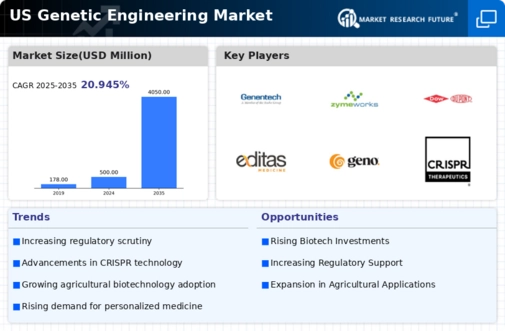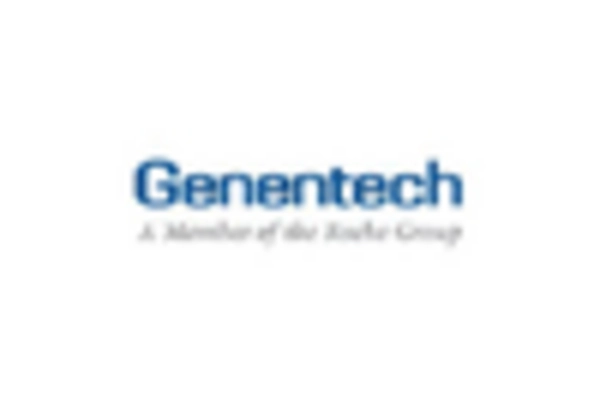The genetic engineering market is characterized by a dynamic competitive landscape, driven by rapid advancements in biotechnology and increasing demand for genetically modified organisms (GMOs) across various sectors, including agriculture and pharmaceuticals. Key players such as Monsanto (US), Bayer (DE), and Amgen (US) are at the forefront, each adopting distinct strategies to enhance their market positioning. Monsanto (US) focuses on innovation in crop biotechnology, emphasizing the development of drought-resistant and pest-resistant seeds, which aligns with the growing need for sustainable agricultural practices. Bayer (DE), on the other hand, has been actively pursuing mergers and acquisitions to expand its portfolio, thereby enhancing its capabilities in genetic engineering and crop protection. Amgen (US) is leveraging its expertise in biopharmaceuticals to explore gene therapies, indicating a shift towards personalized medicine, which is becoming increasingly relevant in the healthcare sector. Collectively, these strategies contribute to a competitive environment that is both concentrated and evolving, as companies seek to differentiate themselves through technological advancements and strategic partnerships.
In terms of business tactics, companies are increasingly localizing manufacturing and optimizing supply chains to enhance efficiency and reduce costs. The market structure appears moderately fragmented, with several key players exerting significant influence. This fragmentation allows for a variety of innovations and approaches, fostering a competitive atmosphere where companies must continuously adapt to maintain their market share. The collective influence of these major players shapes the market dynamics, as they engage in strategic collaborations and investments to bolster their competitive edge.
In October 2025, Corteva (US) announced a partnership with a leading agricultural technology firm to develop advanced gene-editing tools aimed at improving crop yields. This strategic move underscores Corteva's commitment to innovation and its focus on addressing the challenges posed by climate change and food security. By leveraging cutting-edge technology, Corteva positions itself as a leader in sustainable agriculture, potentially reshaping the competitive landscape in the sector.
In September 2025, Regeneron Pharmaceuticals (US) launched a new gene therapy aimed at treating a rare genetic disorder, marking a significant advancement in its biopharmaceutical offerings. This initiative not only highlights Regeneron's dedication to addressing unmet medical needs but also reflects the growing trend of integrating genetic engineering into therapeutic solutions. The successful implementation of this therapy could enhance Regeneron's reputation and market position in the rapidly evolving field of gene therapy.
In August 2025, Syngenta (CH) expanded its research and development facilities in the US, focusing on the development of genetically modified crops that are resistant to emerging pests and diseases. This expansion indicates Syngenta's proactive approach to maintaining its competitive edge in the agricultural sector, as it seeks to provide farmers with innovative solutions that enhance productivity and sustainability. The investment in R&D is likely to yield long-term benefits, reinforcing Syngenta's market presence.
As of November 2025, current trends in the genetic engineering market are increasingly defined by digitalization, sustainability, and the integration of artificial intelligence (AI) in research and development processes. Strategic alliances are becoming more prevalent, as companies recognize the value of collaboration in driving innovation and addressing complex challenges. Looking ahead, competitive differentiation is expected to evolve, with a notable shift from price-based competition to a focus on innovation, technological advancements, and supply chain reliability. This transition may redefine the competitive landscape, as companies that prioritize these elements are likely to emerge as leaders in the genetic engineering market.

















Leave a Comment